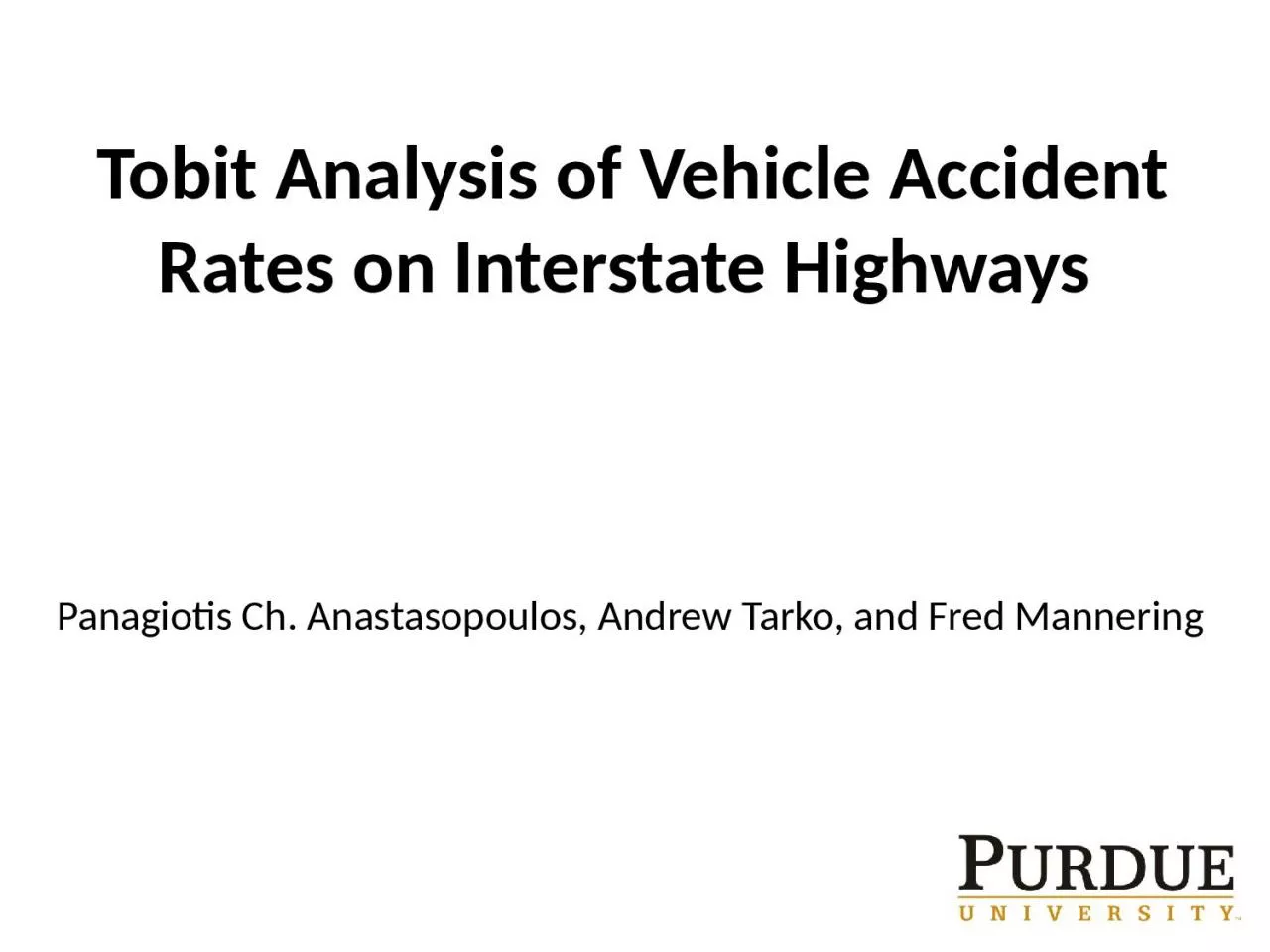

Panagiotis Ch Anastasopoulos Andrew Tarko and Fred Mannering Accident Frequency Modeling Number of accidents on a roadway segment per some unit time As a function of roadway geometrics traffic and weather conditions ID: 1028446
Download Presentation The PPT/PDF document "1 Tobit Analysis of Vehicle Accident Ra..." is the property of its rightful owner. Permission is granted to download and print the materials on this web site for personal, non-commercial use only, and to display it on your personal computer provided you do not modify the materials and that you retain all copyright notices contained in the materials. By downloading content from our website, you accept the terms of this agreement.
1. 1Tobit Analysis of Vehicle Accident Rates on Interstate Highways Panagiotis Ch. Anastasopoulos, Andrew Tarko, and Fred Mannering
2. Accident Frequency ModelingNumber of accidents on a roadway segment per some unit time.As a function of roadway geometrics, traffic and weather conditionsHas been modeled with:Poisson regressionNegative Binomial Zero-inflated Poisson and Negative BinomialRandom Parameters Negative Binomial2
3. Consider a different approach:Instead of looking at “frequency” of accidents, consider accident rates (accidents per 100 million VMT)Advantages:Accidents per 100 million VMT is a commonly reported statistic in government reports and the popular pressProvides an intuitive appeals for interpretation of results 3
4. Problems with an accident rate approach:Variable is now continuous and “censored” (many roadway segments will have zero observed accidents in a specified time period)OLS regression is thus not appropriateOption: Tobit model4
5. Censored dataCensored data: Data can be at a lower threshold (left censored), an upper threshold (right censored), or both. Censored data differ from truncated data –truncated data only have non-limited values available (censored data provide information on limited data as well). 5
6. Tobit model (James Tobin, 1958) (1981 Nobel Laureate)The tobit model is expressed (for roadway segment i) using a limit of zero (which will be the case for our analysis) as:6
7. where N is the number of observations, Yi is the dependent variable (accidents per 100-million vehicle miles traveled), Xi is a vector of independent variables (traffic and roadway segment characteristics), β is a vector of estimable parameters, and εi is a normally and independently distributed error term with zero mean and constant variance σ2. It is assumed that there is an implicit, stochastic index (latent variable) equal to which is observed only when positive. Where:7
8. Tobit Model is estimated by maximum likelihood estimationWith likelihood function:8
9. Empirical setting337 segments (Indiana Interstates)Individual characteristics of each section aggregated into segment-level observationsFive-year accident data (January 1995 to December 1999)Segment-defining information included shoulder characteristics (inside and outside shoulder presence and width and rumble strips), pavement characteristics (pavement type), median characteristics (median width, type, condition, barrier presence and location), number of lanes, and speed limit.
10. Dependent variable:Accident Ratei is the number of accidents per 100-million VMT on roadway segment i, Year denotes the year (from 1 to 5 representing 1995 to 1999), AccidentsYear,i is the number of accidents, AADTYear,i the average annual daily traffic, Li the length of roadway segment i. 10
11. Findings11
12. Pavement Characteristics:(-) High-friction indicator variable (1 if all 5-year friction readings are 40 or higher, 0 otherwise), (-) Smooth pavement indicator variable (1 if 5-year IRI readings are below 75, 0 otherwise), (-) Excellent rutting indicator variable, (1 if all 5-year rutting readings are below 0.12 inches, 0 otherwise) , (-) Good rutting indicator variable (1 if all 5-year average rutting readings are below 0.2 inches, 0 otherwise) , (+) Average PCR indicator (1 if greater than 95, 0 otherwise) 12
13. Geometric Characteristics:(-) Median width indicator variable (1 if greater than 74 feet, 0 otherwise), (-) Median barrier presence indicator variable (1 if present, 0 otherwise), (-) Inside shoulder width indicator variable (1 if 5 feet or greater, 0 otherwise) , (-) Outside shoulder width (in feet), (-) Number of bridges (per road section) 13
14. Geometric Characteristics (cont.):(-) Rumble strips indicator variable (1 if both inside and outside rumble strips are present, 0 otherwise)(-) Number of vertical curves per mile, (+) Ratio of the vertical curve length overthe road section length (in tenths), (-) Horizontal curve's degree curvature indicator variable (1 if average degrees per road section is greater than 2.1, 0 otherwise) , (+) Number of ramps in the driving direction per lane-mile. 14
15. Traffic Characteristics:(-) AADT of passenger cars (in 1,000 vehicles per day), (-) Average daily percent of combination trucks. 15
16. SummaryTobit regression is a plausible method for accident-rate analysis analysisApproach provides an intuitive interpretation of accident rate dataTobit models avoid the theoretical problems that some have with zero-inflated models16